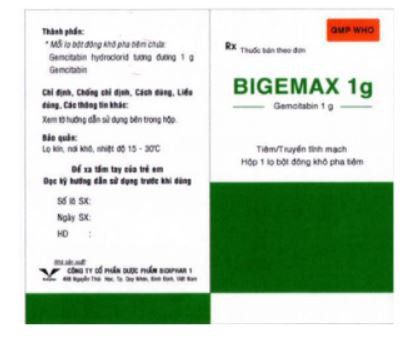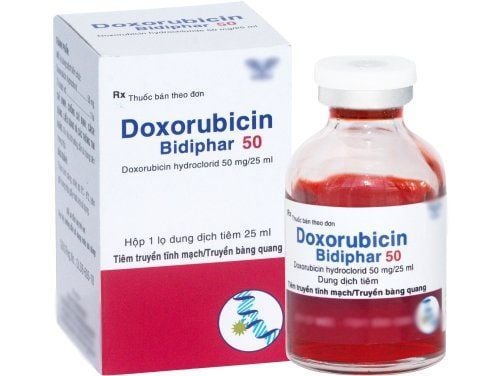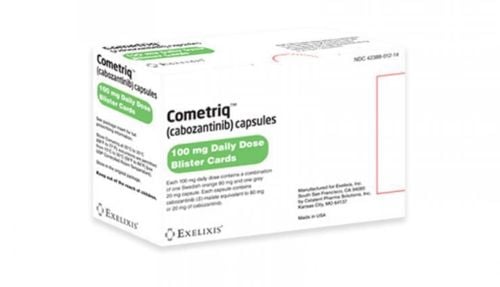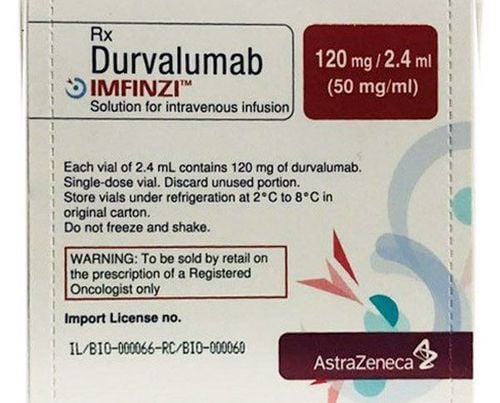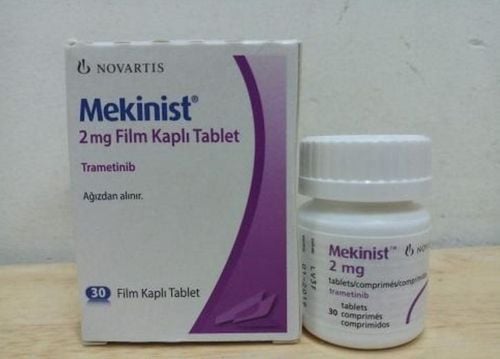This is an automatically translated article.
Gemcisan is prepared in the form of lyophilized powder for infusion, with the main ingredient being Gemcitabine. The drug is used in the treatment of certain cancers: Bladder, lung, pancreas, breast, ovarian.
1. What diseases does Gemcisan treat?
1 Gemcisan vial contains Gemcitabine Hydrochloride equivalent to 200mg Gemcitabine and other excipients. Gemcitabine has a significant cytotoxic effect on some tumor cells, mainly in the process of DNA synthesis. Besides, Gemcitabine also has anti-tumor activity.
Indications for the use of Gemcisan in the following cases:
Gemcitabine in combination with Cisplatin for the treatment of locally advanced or metastatic bladder cancer; Gemcitabine for the treatment of patients with locally advanced or metastatic adenocarcinoma of the pancreas; Gemcitabine in combination with cisplatin for the treatment of locally advanced or metastatic non-small cell lung cancer. Gemcitabine can be monotherapy for elderly patients (over 65 years old); Gemcitabine in combination with carboplatin for the treatment of locally advanced or metastatic epithelial ovarian carcinoma, in patients with recurrence at least 6 months after platinum-based chemotherapy; Gemcitabine in combination with paclitaxel for the treatment of patients with inoperable breast cancer, locally recurrent or metastatic breast cancer after adjuvant chemotherapy. Prior chemotherapy with anthracycline is recommended (unless contraindicated). Gemcisan is contraindicated in people who are hypersensitive to the active ingredients, excipients of the drug or women who are breastfeeding.
2. How to use and dose Gemcisan
Usage: Intravenous infusion. The drug was well tolerated during infusion, the patient was able to walk. If extravasation occurs, the infusion should be stopped immediately and the drug should be started in another vein. The patient should be closely monitored after the infusion.
Dosage:
Usual dose:
Bladder cancer: Recommended dose Gemcitabine 1000mg/m2, 30 minutes infusion on days 1, 8 and 18 in each 28-day cycle; in combination with cisplatin 70mg/m2 infusion on the first day after Gemcitabine or the second day of the cycle. Then repeat the 4-week cycle. Next, based on the degree of toxicity in the patient, the dose can be reduced in 1 or in each cycle; Pancreatic cancer: Gemcitabine dose 1000mg/m2 is recommended, infused 30 minutes once a week for 7 weeks, then discontinued for 1 week. Subsequent cycles were given once a week for 3 consecutive weeks and then stopped for 1 week. Next, based on the degree of toxicity in the patient, the dose can be reduced in 1 or in each cycle; Non-small cell lung cancer: Monotherapy: Gemcitabine dose is recommended at 1000 mg/m2, infusion every 30 minutes once a week for 3 weeks, then stop for 1 week. Repeat this cycle the next time. Next, based on the degree of toxicity in the patient, the dose can be reduced in 1 or in each cycle; Combination therapy: Gemcitabine dose of 1250 mg/m2 is recommended, as a 30-minute infusion on days 2 and 8 of a 21-day cycle. Next, based on the degree of toxicity in the patient, the dose can be reduced for 1 or at each cycle. As for cisplatin, the dose is 75-100mg/m2 x 1 time/3 weeks; Breast cancer: Combination of gemcitabine with paclitaxel. Administer paclitaxel at a dose of 175 mg/m2 intravenously every 3 hours on the first day. This was followed by Gemcitabine 1250 mg/m2 as a 30-minute intravenous infusion on days 1 and 8 of a 21-day cycle. Next, based on the degree of toxicity in the patient, the dose can be reduced for 1 or at each cycle. A granulocyte count should be at least 1500 x (10^6/l) before starting combination therapy; Ovarian cancer: Combination of gemcitabine with carboplatin. Gemcitabine 1000mg/m2 administered as a 30-minute infusion on days 1 and 8 of a 21-day cycle. Thereafter, carboplatin administration on day 1 corresponds to a target AUC (area under the curve) of 4 mg/ml min. Next, based on the degree of toxicity in the patient, the dose can be reduced for 1 or at each cycle. *Note: Need to monitor to detect toxicity, adjust dose for patients accordingly.
Dosage in special patient groups:
Patients with hepatic or renal impairment: Gemcisan should be used with caution due to insufficient information from clinical studies to determine the recommended dose; Elderly (over 65 years): The drug is well tolerated, no dose adjustment is required; Children (under 18 years): Gemcisan is not recommended because there are insufficient data on safety and efficacy. Overdose: There is no antidote to Gemcitabine overdose. High doses of 5700 mg/m2 intravenously over 30 minutes every 2 weeks may cause clinically acceptable toxicity. When using Gemcisan drug overdose, it is necessary to monitor the blood cell count, supportive treatment can be given when needed.
3. Gemcisan side effects
When using Gemcisan, patients may experience some side effects such as:
Blood and lymphatic system: Leukopenia, marrow failure, thrombocytopenia, anemia, febrile neutropenia; Immune system: Anaphylactic-type reaction; Metabolism and nutrition: Anorexia ; Nervous system: Headache, somnolence, insomnia, cerebrovascular accident; Cardiovascular system: Myocardial infarction , hypotension, arrhythmias (mainly supraventricular arrhythmias), heart failure, peripheral vasculitis; Respiratory system: Dyspnea (usually mild and transient, requiring no treatment), cough, rhinitis, interstitial pneumonia, bronchospasm, pulmonary edema, acute respiratory distress syndrome in adults; Digestive system: Vomiting, nausea, constipation, diarrhea, ulcers of the oral mucosa, ischemic colitis; Liver, biliary: Increased liver enzymes (ALT and AST), increased alkaline phosphatase, increased bilirubin, increased GGT, severe hepatotoxicity (including liver failure and death); Skin and Subcutaneous Tissue: Rash often with allergic pruritus, alopecia, pruritus, sweating, skin ulceration, vesicles, crusting of the skin, severe skin reactions (including scabbing and bullous dermatitis, hives, Lyell syndrome, Stevens-Johnson syndrome); Musculoskeletal: Back pain, muscle pain; Renal and urinary: Hematuria, mild proteinuria, renal failure, hemolytic uremic syndrome; Other side effects: Flu-like symptoms (headache, fever, chills, loss of appetite, myalgia, asthenia, cough, rhinitis, diaphoresis, malaise, difficulty sleeping), edema or peripheral edema (usually resolved on discontinuation of therapy), infusion site reactions, radiation toxicity.
4. Be careful when using Gemcisan
Before and while using Gemcisan, patients should be aware:
Gemcitabine can inhibit bone marrow function (manifested by leukopenia, thrombocytopenia and anemia). The patient's platelet, white blood cell, and granulocyte count should be monitored prior to each dose. When drug-induced myelosuppression is detected, the dose should be postponed or changed. However, myelosuppression is usually short-lived and usually does not require reduction or discontinuation of medication. Peripheral blood cells may continue to be decreased after Gemcitabine is discontinued. Caution should be exercised when initiating therapy in patients with myelosuppression, taking into account the risk of myelosuppression due to dose accumulation in combination therapy; Gemcitabine infusion in patients with secondary liver cancer or a history of hepatitis, cirrhosis, alcoholism, etc. may aggravate existing liver failure. Periodic laboratory evaluation of liver and kidney function should be performed in patients. At the same time, caution should be exercised when gemcitabine is used in patients with hepatic impairment; Simultaneous radiation therapy (at the same time or less than 7 days apart) with Gemcitabine may cause toxicity to the patient; Yellow fever and other vaccines should not be given to patients being treated with Gemcisan; Gemcitabine should be used with caution in patients with a history of cardiovascular disease due to an increased risk of cardiovascular disorders; Gemcitabine users may experience lung effects, sometimes severe, such as pulmonary edema, adult acute respiratory distress syndrome, interstitial pneumonia. Discontinuation of the drug should be considered if the patient experiences these effects. At the same time, early application of supportive treatment measures to improve this condition; There is an increased risk of hemolytic uremic syndrome in patients receiving gemcitabine. The drug should be discontinued at the first signs of microvascular hemolytic anemia such as increased serum creatinine, increased bilirubin, increased LDH or BUN. When stopping the drug, the patient may have irreversible kidney failure, requiring hemodialysis; Men being treated with Gemcitabine should not father children during and for 6 months after treatment. Sperm cryopreservation may be necessary before taking the drug because it can cause infertility; Gemcisan should be considered in patients on a salt-restricted diet; Gemcisan should not be treated unless required in pregnant women. It is best for women not to become pregnant while taking the drug, if pregnant, it is necessary to notify the doctor immediately; Stop breastfeeding if the mother is taking Gemcisan; Patients taking Gemcisan may experience drowsiness, especially in the presence of alcohol. Therefore, the patient should not drive or operate machinery until the drowsiness is completely gone.
5. Gemcisan drug interactions
Some drug interactions of Gemcisan include:
Radiation therapy at the same time as Gemcitabine (administered at the same time or not more than 7 days apart) can cause combined toxicity. Gemcitabine can be started apart from radiation therapy before and after 7 days; Yellow fever vaccine or other vaccines are not recommended while receiving Gemcitabine because of the risk of potentially fatal systemic illness, especially in immunocompromised patients. Gemcisan has many potential side effects. When prescribed drugs to treat cancer, patients should strictly coordinate with all instructions of the doctor to ensure the highest effectiveness of treatment and control the risk of unpredictable complications.
Please dial HOTLINE for more information or register for an appointment HERE. Download MyVinmec app to make appointments faster and to manage your bookings easily.




